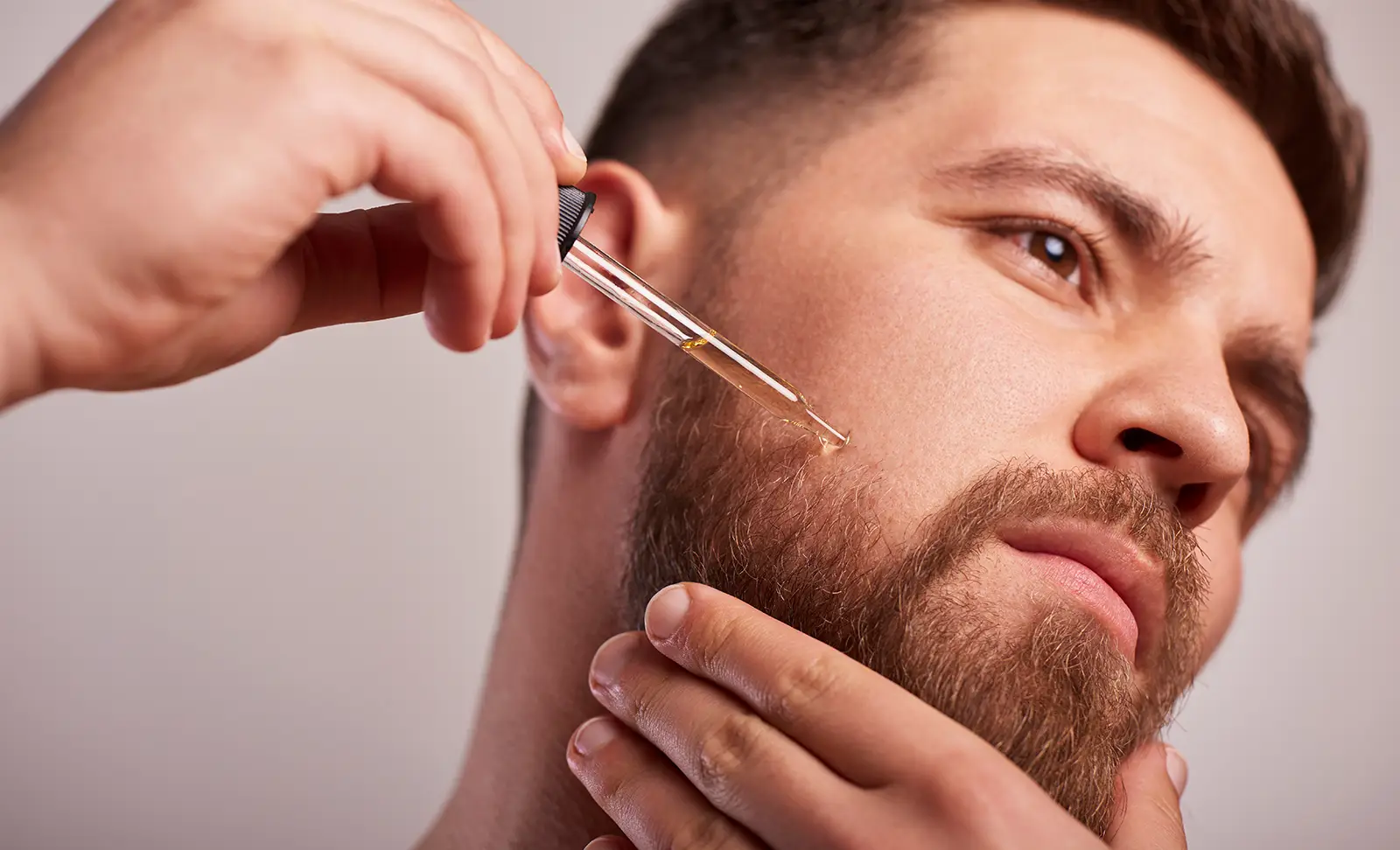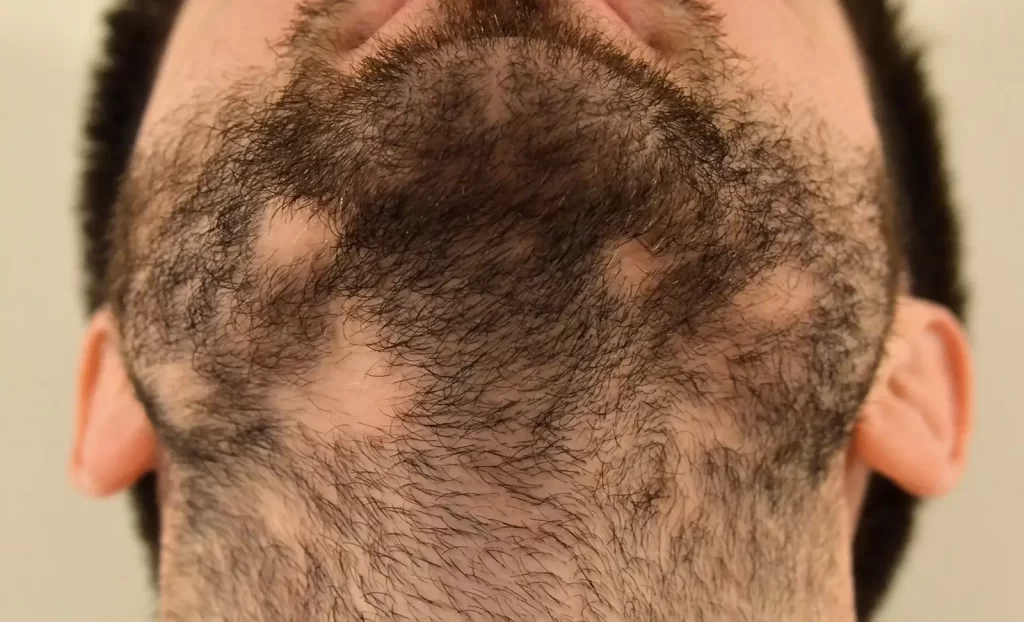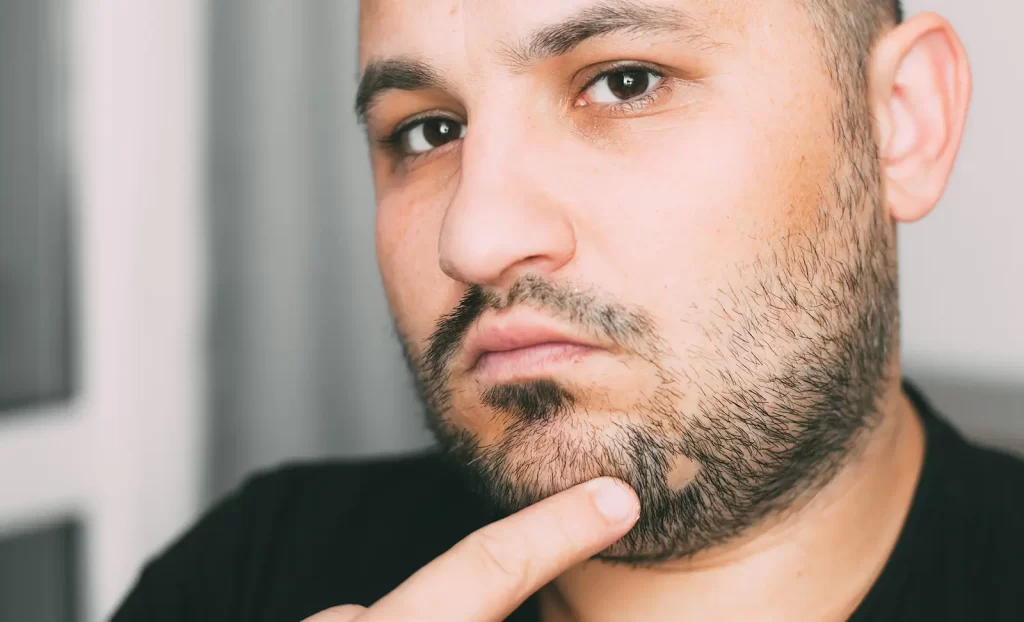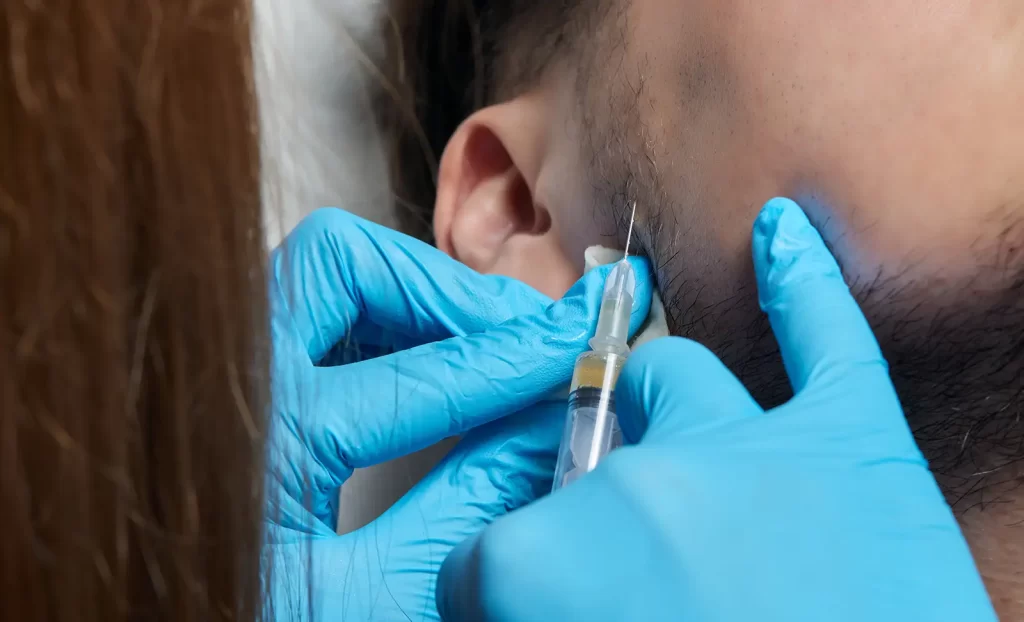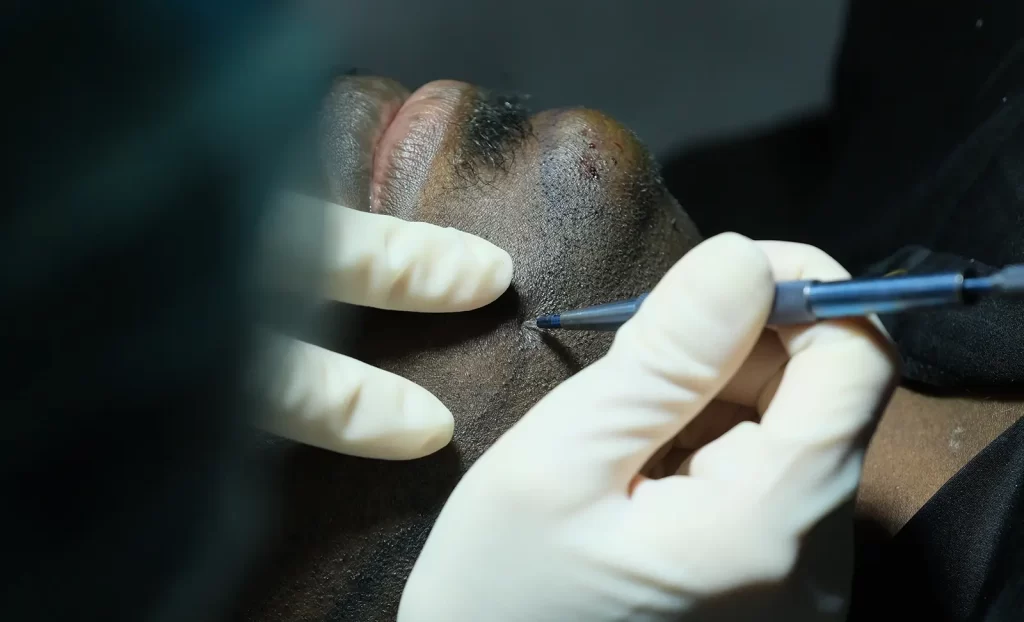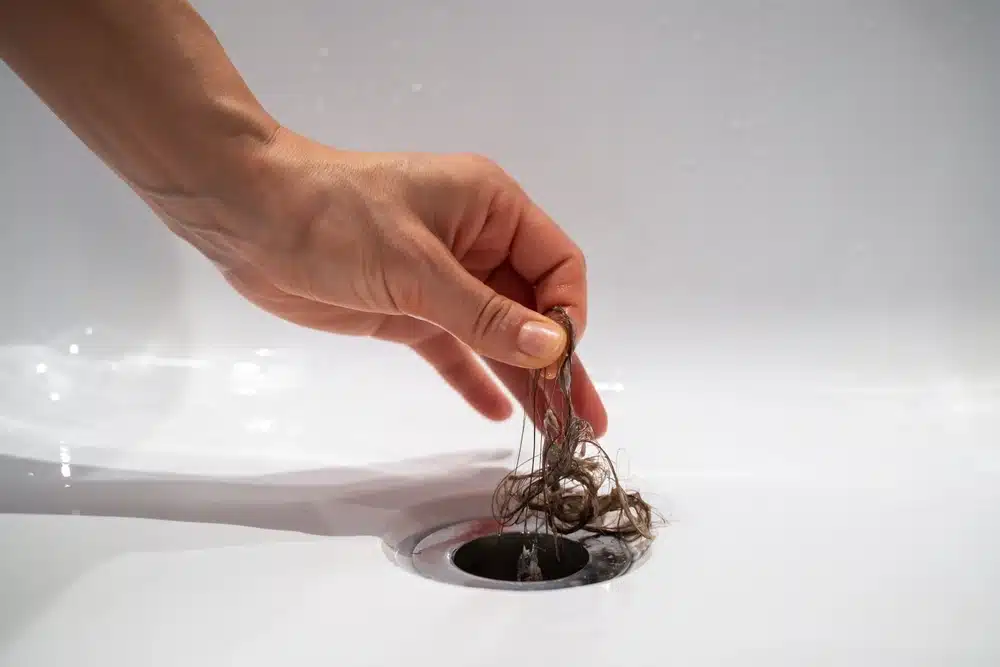Hair loss is often noticed and talked about. It’s very common, after all, with male pattern baldness affecting around half of men over the age of 40. [1] What about beard hair loss? Baldness in the beard may not be as common as on the head, but it’s still a reality for many men around the globe. The technical term for it is “alopecia barbae”.
What Exactly is Alopecia Barbae?
Alopecia is a common autoimmune disease in which the immune system attacks healthy cells – specifically, hair follicles. Alopecia barbae (also known as beard alopecia) is a specific type that specifically targets the beard area, leading to a bald, patchy beard in men. Usually, these patches are small and circular and appear around the jawline. Some people with beard alopecia also experience hair loss in other areas of their body, such as their scalp.
How Common is Alopecia Barbae?
While beard alopecia is not as common as typical male pattern baldness (which affects the scalp), it still affects around 30% of people who already have alopecia – especially those who have excessive cases. [2] If you have alopecia areata, you are more likely to experience bald patches in the beard.
The Causes of Alopecia Barbae
Most of the time, you cannot do much to prevent alopecia barbae, as most of the causes are genetic. Some people are more likely to get beard alopecia than others, including those who have:
- Psychological Stress
- Alopecia Areata
- Nutritional Deficiencies
- Tinea Barbae
- Herpes Simplex Folliculitis
- Frontal Fibrosing Alopecia [3]
The Signs You Have Alopecia Barbae
Have you spotted some bald patches in your beard? It’s natural to be concerned that you have beard alopecia. It’s typically quite easy to spot – here are the signs.
Circular Bald Patches
The first obvious sign of alopecia barbae is bald patches on the beard. These patches are typically small and circular, but they can grow in size over time. Also, they might come on very quickly or appear gradually. It might simply look like a patchy beard, or it might look like large, circular bald patches on the face – there is variety in its typical appearance.
Irritation and Redness
Many people with beard alopecia also experience irritation in the affected area. For example, you might notice redness and itchiness on or around the bald patches, which can be quite uncomfortable. Scratching this area can also lead to even worse hair loss, so it’s worth getting addressed even if beard alopecia isn’t the root cause.
Hairs like Exclamation Marks
Another common sign of beard alopecia is hairs that look a little like exclamation marks. That means the hairs are much narrower towards the bottom, where they are closer to the skin. You may also experience ingrown hairs.
What if You’ve Never Grown a Beard?
It’s important to note that most people who have never previously been able to grow a beard are unlikely to get alopecia barbae. If you’re struggling to grow a beard at all, that is likely due to your genetics than because of an autoimmune disease. Beard alopecia is a disease that affects people who have previously grown a full beard and have later encountered patchiness and bald spots.
How Does Beard Alopecia Affect You?
Fortunately, beard alopecia does not cause any physical harm. That doesn’t mean there aren’t any negative effects, though – baldness in the beard is more than just an aesthetic problem. It can seriously affect your self-confidence, which can, in turn, affect your social life, with some people with hair loss finding that their work and personal lives suffer as a consequence. One study has even linked alopecia areata with a greater risk of depression and anxiety. [4] Due to this, it’s important to get to the root cause of your beard hair loss and find the correct treatment for you.
Getting Alopecia Barbae Diagnosed
To get diagnosed with alopecia barbae, you’ll typically need to see a specialised dermatologist. During your appointment, the doctor will look closely at your beard. They’ll likely take samples of your beard and perhaps even perform a biopsy to confirm whether alopecia barbae is the root cause of your patchy beard.
Alopecia Barbae Treatment Options
There is good news! There are alopecia barbae treatment options. One might work well for you, while another may not. Your doctor should be able to work with you to find the best treatment option that helps you with beard hair growth.
Corticosteroids
One of the most common beard alopecia treatments is a prescription of corticosteroids. This is a steroid that is used to treat all types of alopecia with very promising results, and can either be administered topically or via injections.
Finasteride
Another commonly prescribed alopecia barbae treatment is finasteride. This DHT-blocking medication is most commonly used to treat enlarged prostates but can also be used to prevent hair loss – including in the beard.
Minoxidil
Minoxidil is a hair loss treatment you can get without a prescription (although many people like to pair it with finasteride for even better results). When applied topically, minoxidil can help regrow hair over time. It needs to be used every single day, but it can be worth it for maintaining a beard that stays thick and healthier for longer.
Diphencyprone
Sometimes, doctors will prescribe diphencyprone to treat alopecia. While it doesn’t work for everyone, around 74.6% of people with patchy alopecia do experience some hair regrowth. [5]
Beard Transplants
If medications don’t work or you want a more permanent solution, there is the option of a beard transplant. Beard transplants are a lot like hair transplants, only they focus on the beard. There are two kinds: FUE and FUT, with FUE extracting individual follicles, whereas FUT extracts multiple follicles in one graft. Once extracted and implanted into the affected area of the beard, you can expect to see the full results of normal beard growth in a matter of months.
Is a Beard Transplant Right for You?
If you have beard alopecia, a beard transplant might be your ideal treatment option, particularly if other hair loss medications have not worked. To be a good candidate for the surgery, you must have a good donor area (usually the back of your scalp). In terms of how old you are, there isn’t a specific age you need to be – if you have suffered hair loss from the beard at an accelerated rate, a beard transplant could likely help you.
If you’re still unsure whether a beard transplant is the right choice for you, contact our friendly and professional team at HS Hair Clinic. We offer consultations with the best surgeons in the business so you can be sure of your decision.
Another Option: Shaving
Most people would agree that a fully shaved beard looks better than a very patchy and balding one, which is why many people experiencing beard alopecia choose to shave the area completely. Of course, this can be devastating – especially if you are attached to your beard and see it as part of your identity. Still, it’s an option worth considering, especially if medications like steroids and minoxidil do not work and you don’t want to go down the surgery route.
Do be aware that shaving won’t make your beard hair grow back thicker. There is a myth that this happens, but it’s just that: a myth.
Prevention Tips for Alopecia Barbae
Most people would rather prevent beard alopecia than have to deal with it via treatment options. Here are some prevention tips.
Start a Beard-Grooming Routine
Maintaining a beard can be harder than you’d think, but it’s very important. Good habits like regularly combing, oiling, and trimming can help you maintain a healthy, thick beard for longer. At the same time, don’t be too aggressive with your routine, as this could cause damage. Take a look at our beard grooming guide for some handy advice!
Decrease Stress Levels
Did you know that stress can lead to hair loss? It’s true. That’s why it’s so important to lower your stress levels as much as possible. If your stress is getting out of control, it’s worth speaking to a doctor.
Address Nutritional Deficiencies
Sometimes, beard hair loss is caused by nutritional deficiencies – particularly deficiencies in zinc, magnesium, biotin, and vitamins A, B, D, and E. So, to stop your beard from shedding, quickly address any of these nutritional deficiencies.
In Summary
Beard alopecia causes circular patches in the beard and can seriously affect your self-confidence, leading to self-esteem issues. You don’t have to put up with it, though. Aside from completely shaving the area, there are plenty of treatment options, including medications like corticosteroids and surgical options like a beard transplant.
Sources:
